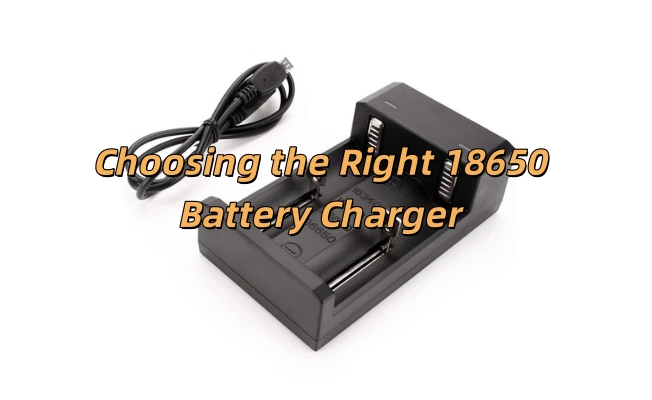When it comes to maintaining your 18650 batteries, choosing the right charger is crucial. Whether you're charging batteries for electronics, power tools, or electric vehicles, the charger you use plays a significant role in battery performance, longevity, and safety. In this comprehensive guide, we will walk you through the different types of 18650 battery chargers, key factors to consider when choosing one, and the best practices for charging your batteries.

1. Single-Bay Chargers
Single-bay chargers are perfect for users who need to charge one battery at a time. They are portable, easy to use, and typically come with basic safety features like overcharge protection. Some advanced models also feature LCD screens to display charging status or battery voltage, making them a great option for those who want a simple, reliable charger.
2. Multi-Bay Chargers
Multi-bay chargers are ideal for users who need to charge several batteries simultaneously. With options ranging from dual-bay to eight-bay configurations, these chargers often offer independent charging slots, allowing users to monitor the progress of each battery. They are efficient and perfect for those managing multiple devices or batteries.
3. Smart Chargers
Smart chargers come with adjustable output current and voltage settings for precise charging. They offer advanced safety features, including overcharge protection, short circuit prevention, and reverse polarity protection. Some smart chargers even include battery conditioning and diagnostic functions to ensure your battery is always in top shape.
4. Fast Chargers
Fast chargers utilize technologies like Quick Charge or USB Power Delivery to significantly speed up the charging process. While these chargers are convenient, it’s important to be cautious as fast charging can generate more heat, which could affect the battery’s long-term health.
5. USB Chargers
For added convenience, USB chargers allow you to charge your 18650 batteries on the go, using power banks or laptop USB ports. While these chargers offer flexibility, they may have limited output current and voltage compared to more powerful charging options.
6. DIY Chargers
DIY chargers cater to battery enthusiasts and professionals who want to customize their charging setup. These kits and components allow users to modify charging parameters and build their own charging solutions, offering a more hands-on approach to battery management.

1. Compatibility
Make sure the charger is specifically designed for 18650 batteries and supports lithium-ion and lithium-polymer chemistries. Using an incompatible charger can damage the battery and lead to safety hazards.
2. Safety Features
Safety should always be a top priority when selecting a charger. Look for chargers that include overcharge protection, short-circuit prevention, and temperature regulation. Certifications like CE, UL, or FCC confirm that the charger meets international safety standards.
3. Charging Speed and Modes
Consider the charger’s speed and its available charging modes. Many chargers offer adjustable rates such as 0.5A, 1A, or 2A to suit different battery capacities. While fast charging is appealing, it can negatively impact battery lifespan if used regularly.
4. Number of Charging Bays
If you only need to charge one battery at a time, a single-bay charger may be sufficient. However, for those managing multiple batteries, a multi-bay charger allows you to charge more than one battery simultaneously, saving time and increasing efficiency.
5. Portability and Versatility
For those who travel frequently or need a charger for outdoor use, a compact, USB-compatible charger may be the best option. Choose a charger that fits your specific lifestyle needs and is convenient for use in different settings.
6. User-Friendly Features
Look for chargers with LCD screens, intuitive interfaces, or battery health indicators. These features make it easier to monitor the charging process and ensure your battery stays in good condition.
7. Build Quality and Durability
A charger’s build quality can greatly impact its performance and longevity. Chargers made from durable materials like ABS plastic or aluminum alloys offer better impact resistance and heat dissipation, ensuring long-term reliability.
1. Inspect Your Batteries
Before charging, inspect the batteries for any damage, leaks, or deformities. Damaged batteries should never be charged as they pose a safety risk.
2. Insert Batteries Correctly
Align the positive (+) and negative (-) terminals according to the charger’s markings. This ensures the battery is inserted in the correct direction for safe charging.
3. Select the Appropriate Charging Mode
Choose a slower charging rate for extended battery life. Slower charging can prevent overheating and ensure the battery performs optimally over time.
4. Monitor Charging Progress
Keep an eye on the charging process using any available indicators or LCD screens. Never leave batteries unattended while charging to quickly address any potential issues like overheating or short circuits.
5. Charge in a Safe Environment
Always charge your 18650 batteries in a well-ventilated, non-flammable area, away from extreme temperatures and direct sunlight.
6. Store Batteries Safely
Once fully charged, store the batteries in a protective case to avoid short-circuiting or physical damage. Always follow manufacturer guidelines for charging times, safety precautions, and compatibility.
7. Regular Maintenance
Inspect and clean the charger’s terminals regularly to maintain functionality and ensure a safe, efficient charging process.
Whether you need a charger for single or multiple batteries, speed or portability, selecting the right 18650 battery charger is essential for battery performance and safety. By considering the charger’s compatibility, safety features, and build quality, you can ensure your batteries are charged efficiently and securely. Remember, always follow the manufacturer’s instructions and safety guidelines for optimal battery health and longevity.
Next:CATL Unveils Next-Gen 587Ah LiFePO4 Energy Storage Cell Setting New Industry Benchmark
Previous:BYD and ByteDance Partner to Drive AI-Powered Innovations in Lithium Battery Development
Contact Person: Miss. Kiki
| WhatsApp : | +8617763224709 |
|---|---|
| Skype : | +8617763224709 |
| WeChat : | +8617763224709 |
| Email : | kiki@lifepo4-battery.com |